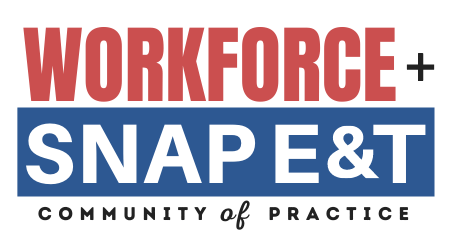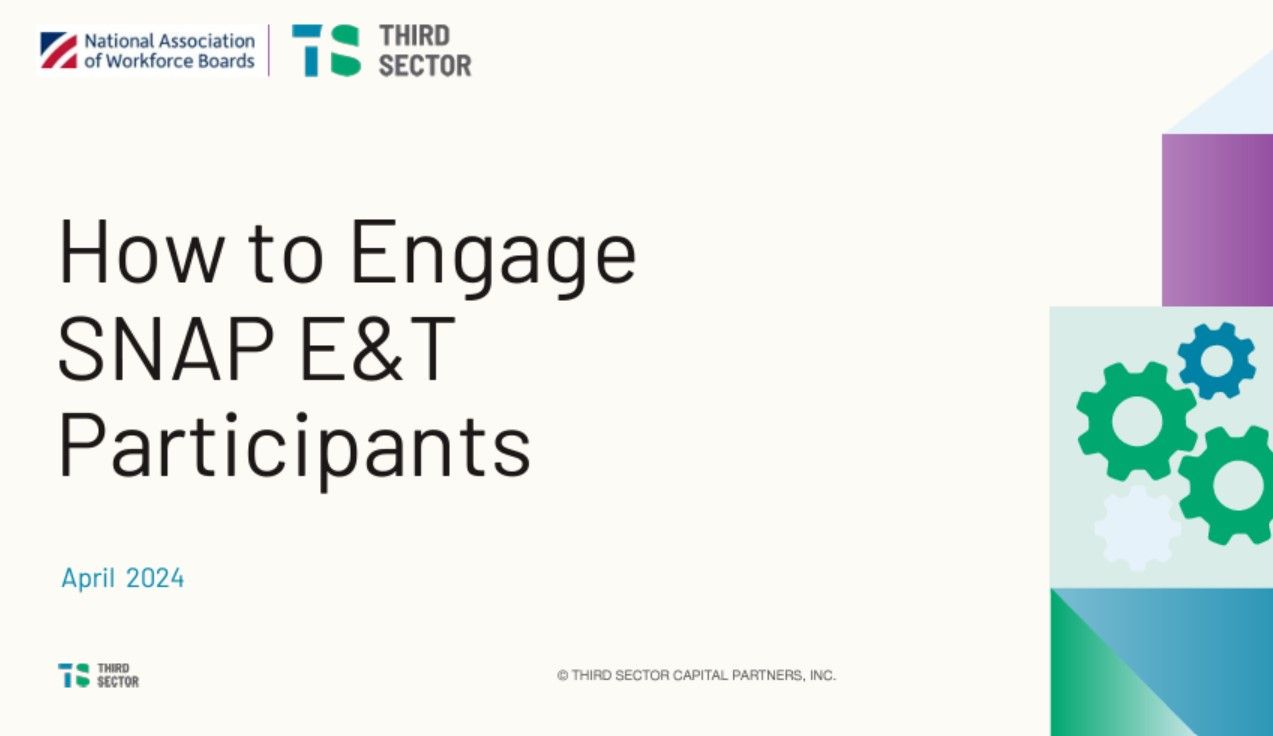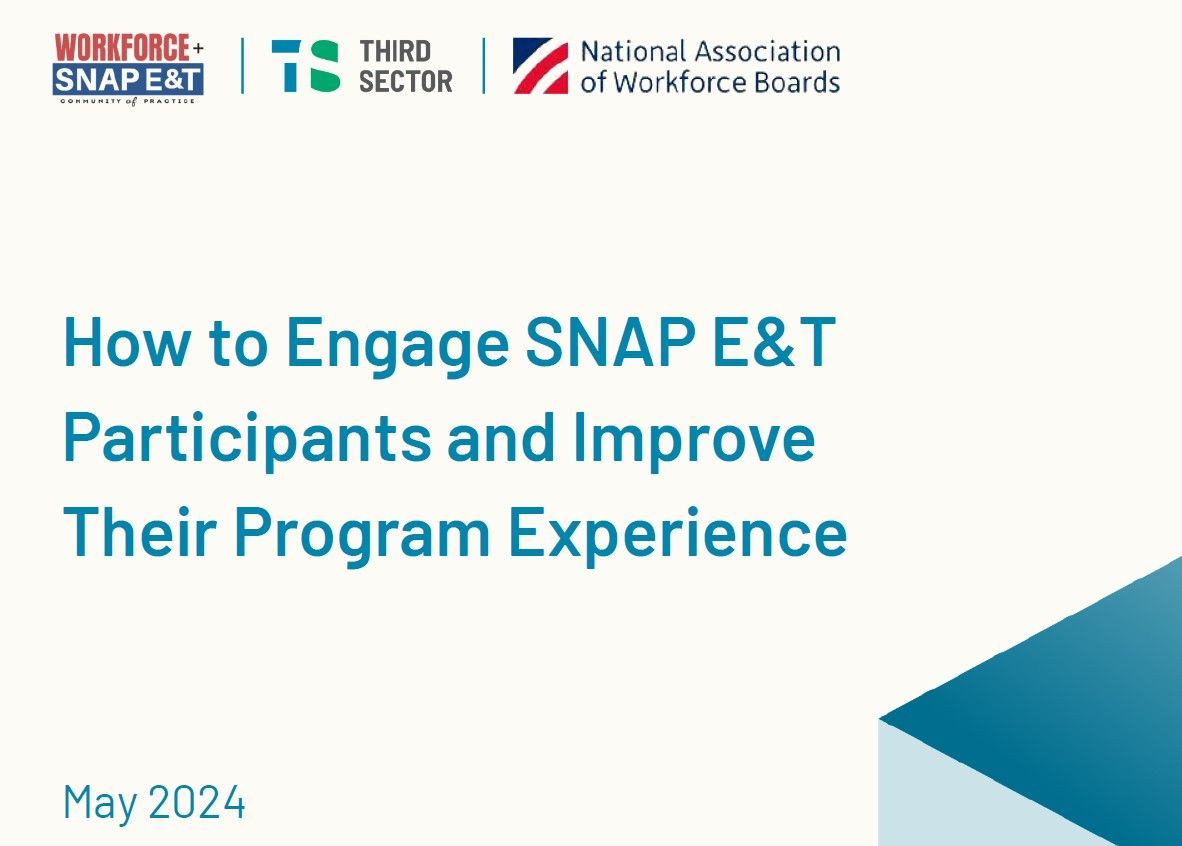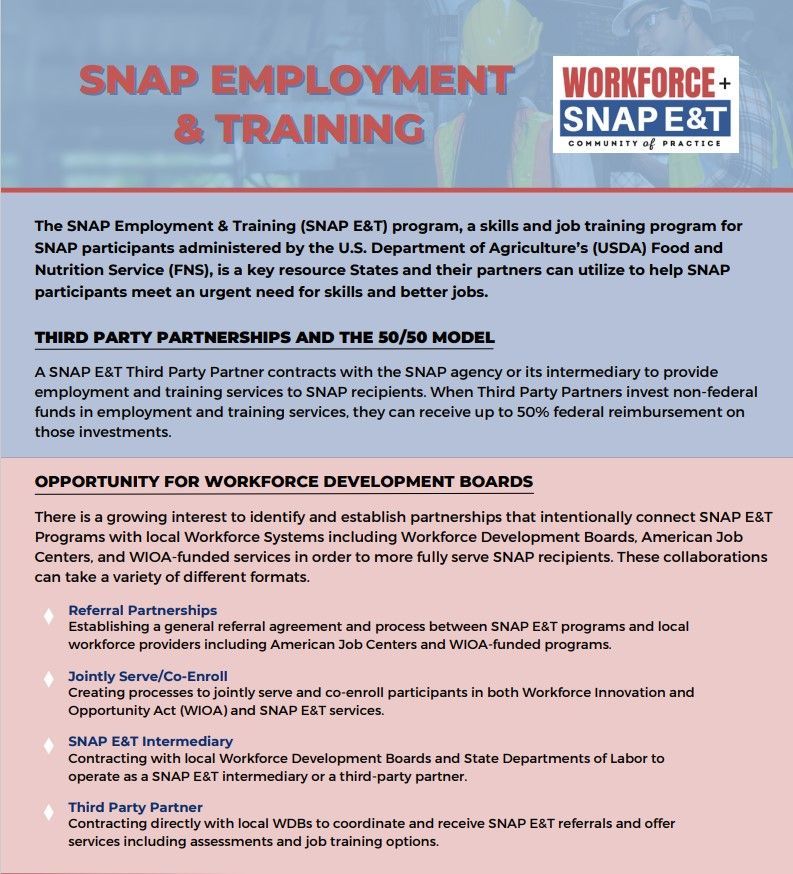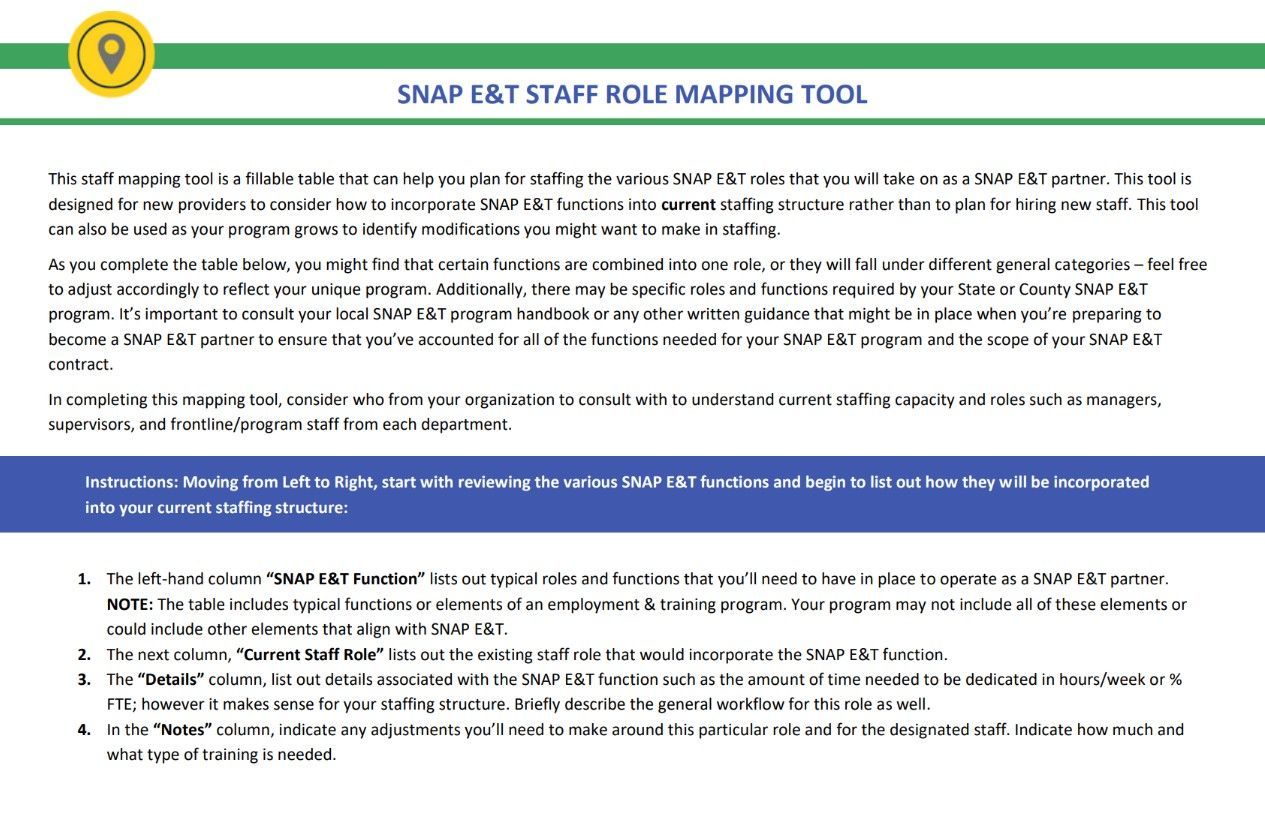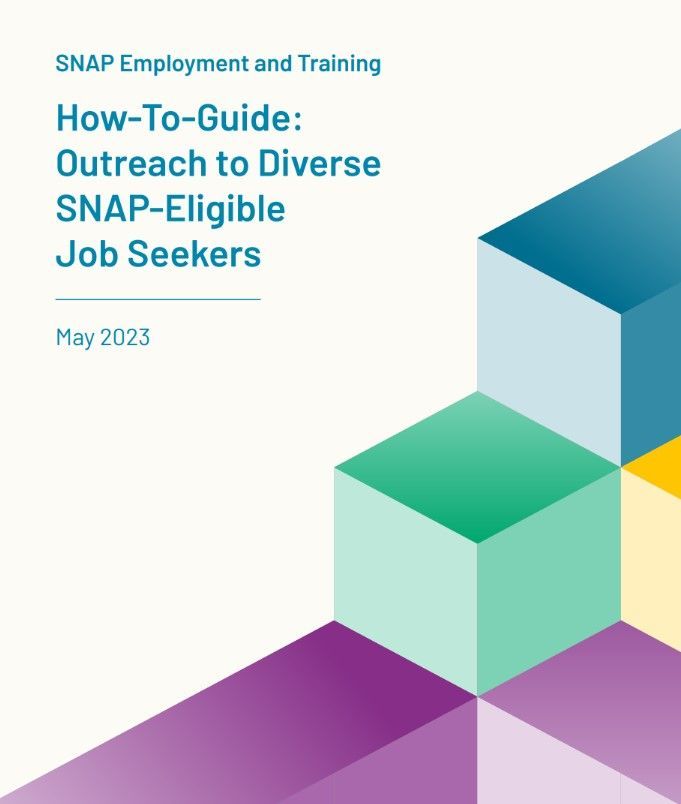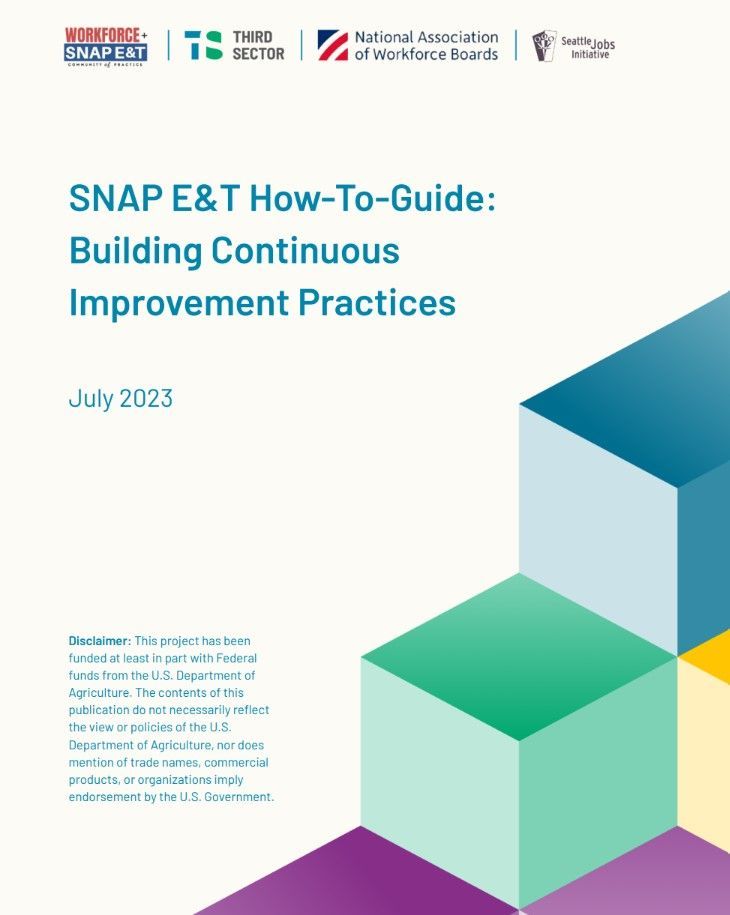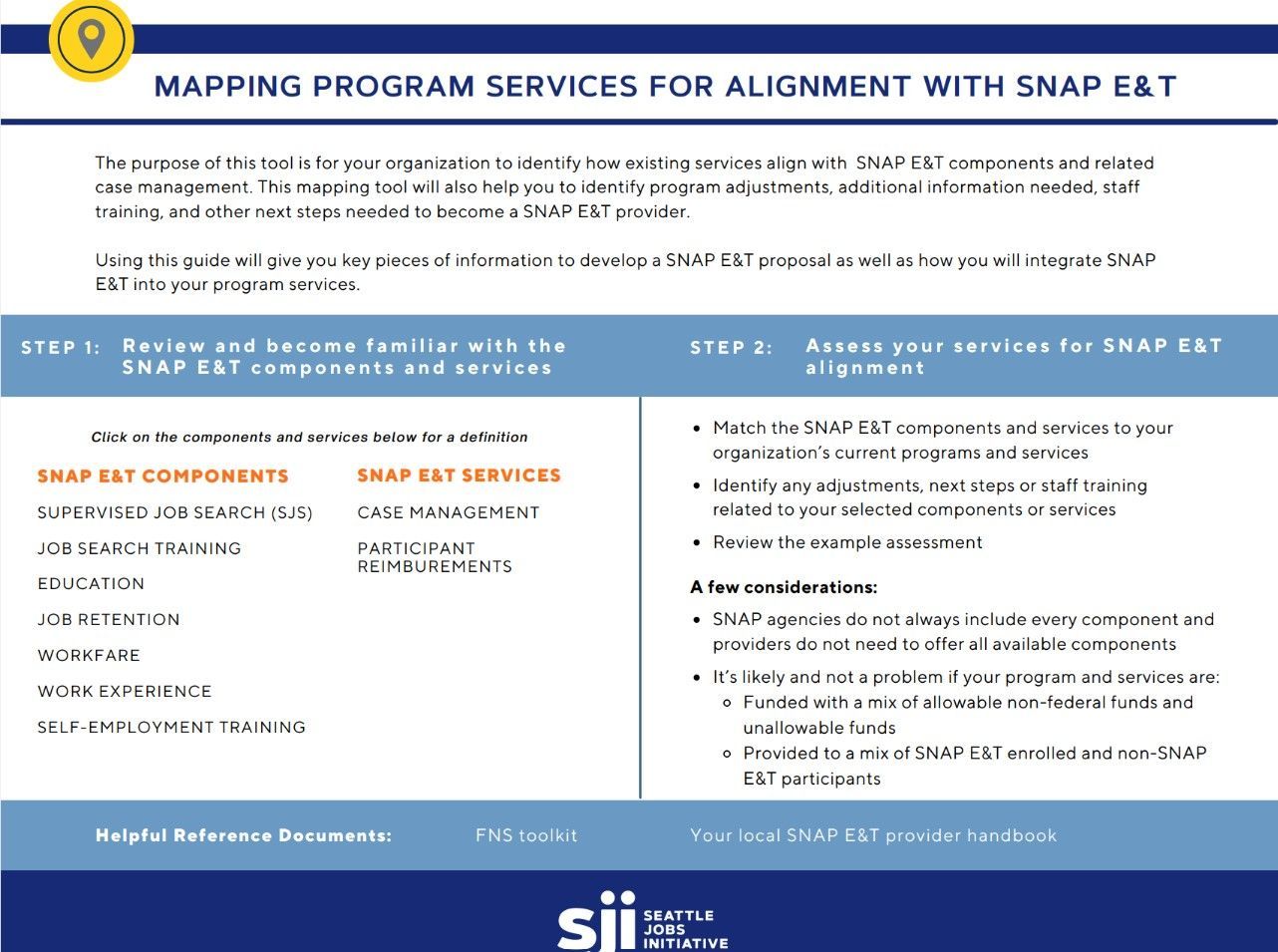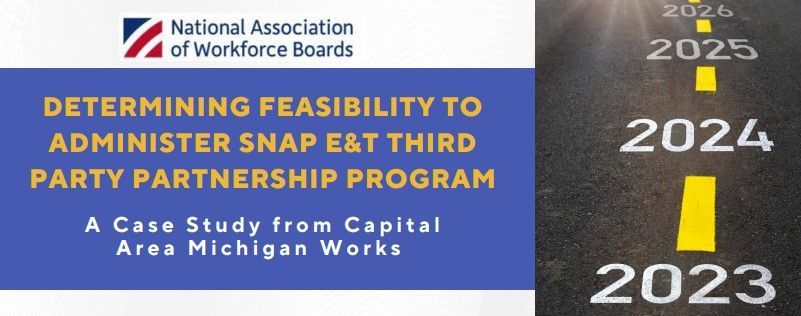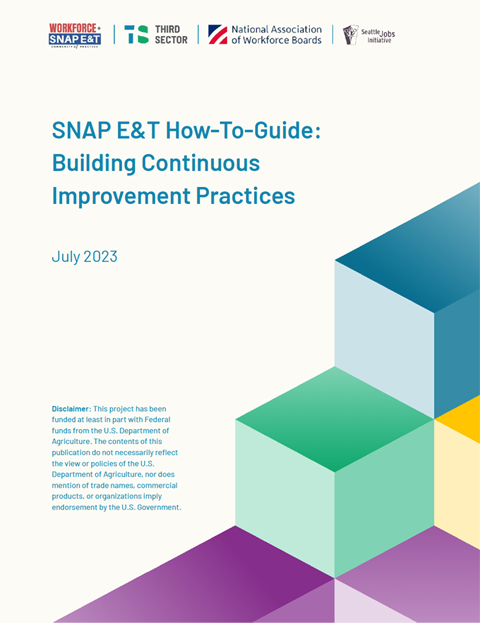WORKFORCE + SNAP E&T COMMUNITY OF PRACTICE TOOLS & RESOURCES
TOOLS & RESOURCES
New Resources from SNAP E&T: Maximizing Engagement (Third Sector)
Resource:
SNAP E&T Overview
SNAP E&T How-To-Guide: Building Continuous Improvement Practices
FAQ About SNAP E&T
SNAP E&T FEDERAL REGULATIONS
Does SNAP have its own outcomes? Is there overlap with SNAP E&T?
SNAP is focused on increasing food security while SNAP E&T, a program within SNAP, is focused on helping SNAP participants get skills needed to improve their employment prospects (employment is clearly tied to self-sufficiency, increased income and food security). SNAP does have outcomes related to program integrity and participation rates (potential eligible for SNAP compared to actual SNAP enrollments), but meeting these outcomes is not part of SNAP E&T or the responsibility of SNAP E&T partners. SNAP E&T tracks similar outcome measures as WIOA. While outcomes must be reported by State agencies to USDA/FNS, they are not tied to funding.
What will FNS’ proposed new rules on case management mean for implementation around SNAP E&T?
The Food and Nutrition Act of 2008 (as amended December 2019) requires that SNAP E&T participants be provided robust and integrated case management services, such as “comprehensive intake assessments, individualized service plans, progress monitoring, or coordination with service providers….” States, in designing their SNAP E&T programs and services, will have a lot of flexibility as to the duration and manner a participant receives case management, though it should ideally be individualized, adaptable and ongoing to support participants to successfully participate and move through a SNAP E&T service component to completion/employment. States are currently receiving further guidance and training on new SNAP E&T regulations from FNS, so it will take time to learn how each State will handle this.
SNAP E&T PROGRAM ADMINISTRATION
Is SNAP E&T the same across all States?
While SNAP E&T is a required element of every State’s SNAP program, States have great flexibility in how their SNAP E&T programs are designed and operated. It is safe to say that no two SNAP E&T programs are alike. Variables include the size or number of SNAP participants being served, whether SNAP E&T participation is mandatory for SNAP recipients, whether SNAP and therefore SNAP E&T is State or County administered in that State, the quantity and types of SNAP E&T third party partners, and the range of SNAP E&T components offered. So while federal regulations provide a framework for SNAP E&T across the U.S., those interested in better understanding SNAP E&T in their State should consult with their State agency.
SNAP E&T FUNDING
How much funding does a SNAP E&T intermediary receive?
This really depends on the type of arrangement an intermediary has with the State agency. Some intermediaries receive a portion of the State’s 100% SNAP E&T funds to cover their expenses associated with executing their intermediary functions. In other models, the intermediary organization keeps a percentage of the 50% reimbursement of provider partners’ non-federally funded services back to cover the additional administrative costs associated with their role. Many intermediaries hold no funds back, while some hold back 4%-5%, and some hold back a larger percentage (10%-20%). There is currently no federal policy or guideline for a hold back percentage.
How much money can we receive through a SNAP E&T contract? And is it a set amount for each County or based on some population calculation?
A contract may be paid by either 100% funds or 50-50 funds. 100% funds are capped at the State level and presumably, within States, by County, based on the relative number of SNAP work registrants. Accordingly, there is a cap on how much a State or County could spend using 100% funds on any contracted partner. However, there is no set amount for 50-50 funding: it is currently uncapped at the federal level. Some State or County SNAP agencies might approve contracts with pre-established service levels and dollar amounts, but generally, a 50-50 SNAP E&T budget is determined only by your capacity and available non-federal funds to apply to SNAP E&T services.
Where are other workforce agencies reinvesting their match funding?
Partner providers contracted to receive SNAP E&T 50-50 reimbursement funds typically use these funds to build capacity in their programs, either by offering a wider array of services or increasing the number of participants served. State or County SNAP agencies might look at proposed use of reimbursed funds as a factor in their provider selection, but often it takes a while for new providers to grasp how to best use their added capacity. State SNAP agencies can sometimes offer guidance for providers during monitoring to suggest ways they could increase their level of reimbursement by finding additional allowable costs or help them with outreach strategies to bring in more participants.
BECOMING A SNAP E&T CONTRACTED PARTNER
How significant is the grant application? Grant duration?
It depends, as each State (or County) SNAP agency has its own process for screening potential SNAP E&T provider partners. Some States have a formal RFP that is released on a schedule, while others have less formal processes, including processes that are ongoing in which new providers can be added at any time of year. Typically, contracts will last for a full federal fiscal year (or if a provider is contracted mid-year, until the end of the federal fiscal year). Additionally, States have discretion as to how often they repeat their selection process for a providers who are currently contracted; however it is common that providers only go through the selection process once and then re-negotiate their contracts on an annual basis (federal fiscal year).
Is there a complete list of the SNAP E&T State agencies that can be shared?
Currently, there is not a complete list of each State’s SNAP E&T State agency contacts. A helpful tip for locating the correct contact is to start with the SNAP agency which is housed within the State’s department of social or human services and check if there is a SNAP E&T contact listed. We believe a list is currently under development that we will make available if/when completed.
There is already a SNAP E&T provider in our area who serves multiple counties and has been doing so for many years. Does a workforce board with no experience and a smaller footprint of just 6 counties have a chance at getting this contract?
Yes! The SNAP agency does not have to choose a single provider to represent a geographic area; in fact, it should be in the agency’s best interest to add multiple provider partners to increase the range of services available to SNAP E&T participants and the number that can be served. Consider how participants are being served by this other provider and whether you offer something unique and even complementary. Think about how SNAP E&T can help you improve on what you are currently offering, which is already operating alongside what this other provider is offering.
We serve just 6 Counties, should we go after this contract only for our counties so we are best aligning services or attempt to expand beyond our usual footprint?
Yes. Starting with what you currently offer is a good idea. You can always expand your reach as your program becomes more established and you see the opportunity to increase your capacity, including by employing new 50% reimbursement funds from SNAP E&T.
When is the SNAP E&T contract next up for RFP?
Provider selection timelines vary from State to State (and do not always involve an RFP, depending on a State’s procurement processes). But contracts typically run on the Federal Fiscal Year of October through September. States often prefer to identify new providers sometime before their annual SNAP E&T State Plans are due to USDA/FNS (around August) because they must include all proposed providers and their combined budgets and service levels in these Plans that determine the amount of funding FNS will make available to the State for the upcoming FFY. Once FNS approves the State Plan, the State knows it will have the funding to contract providers. All this said, States are free to engage new providers at any time during the year and can amend their State Plans accordingly.
PARTICIPANT ELIGIBILITY
How is ability to work upon program completion determined during eligibility process?
There are no fixed criteria for determining ability to work in SNAP E&T. Ability to work is often determined through a process of assessing the participant’s interests and desire to work along with other factors that would prevent them from working after participating in SNAP E&T.
Can a TANF recipient volunteer as a SNAP E&T participant and can the provider agency be eligible for 50/50 funds?
TANF recipients are not eligible to participate in SNAP E&T therefore a provider would not be able to get 50% reimbursement for services provided to that participant.
SNAP E&T OPERATIONS & CAPACITY
How is a SNAP E&T intermediary defined?
There is no single or formal definition for a SNAP E&T intermediary. Most commonly, an intermediary is an agency that takes on some of the administrative functions required by SNAP E&T that another entity does not have the capacity (or desire) to fulfill. For example, the State SNAP agency may engage (usually via contract) another State agency, a WDB, community college, etc., to help it administer the SNAP E&T program, such as by engaging, contracting and monitoring partner providers. In other instances, larger provider partners might serve in an intermediary role for smaller providers, relieving them of some of the administrative functions needed for SNAP E&T participation.
Is there an enrollment form a person fills out for SNAP and WIOA? Do you help people get on SNAP before they can be served?
For SNAP E&T, all participants must be receiving SNAP benefits to participate in SNAP E&T. SNAP E&T providers can, and often do, help participants who are not yet on SNAP to apply for SNAP benefits through their local SNAP office. Helping a participant enroll in SNAP could also happen at the time of WIOA enrollment at a WDB. Individuals can be co-enrolled in both WIOA and SNAP E&T, and the two programs can often provide complementary services. If a WDB wished to enroll a participant in both WIOA and SNAP E&T, the WDB could refer the participant to the State SNAP agency or a SNAP E&T provider. If the WDB is, itself, a SNAP E&T provider, it would refer the participant to the State agency (reverse referral) to confirm their eligibility.
We currently have an accounting system set up to serve WIOA, Title V/SCSEP and other grants. What other investments would be needed on the accounting side to be able to take on SNAP E&T?
It is likely that you have the necessary infrastructure in place and your experience managing other federal programs is helpful, too, for SNAP E&T. You might need to make minor modifications to add specific fields or programs to those existing systems but having a robust accounting system already in place will likely make it an easier lift. If you are receiving 50-50 funds, you will need to demonstrate to the State agency when billing for reimbursement that the expenses for which you are seeking reimbursement were covered by non-federal funds.
Describe the level of staff support needed to manage this contract.
This depends on the size of your SNAP E&T program, processes and procedures in your State, and other factors. Typically, depending on your current staffing structure, it could involve adding a limited level of new staffing capacity, or possibly, spreading the effort across existing staff. Typical functions include:
- Fiscal/accounting
- Program administration
- Data and reporting
- Frontline (direct) service
Most partner providers, especially those utilizing 50-50 SNAP E&T funds, are not developing a new set of “SNAP E&T services” but are using E&T funds to support their current programming, and thus the staffing is already in place. Limited new capacity is more typically needed to support new functions associated with the SNAP E&T contract administration, such as referral and eligibility processes, data reporting, etc.
How would it work if participants were co-enrolled in SNAP E&T and WIOA?
You would have to determine up front what distinct services SNAP E&T could offer outside of what was available through WIOA and ensure that you’re tracking costs accordingly to ensure that you’re not duplicating services. For example, SNAP E&T services could step in to provide more intensive support beyond what WIOA can provide to help participants with higher employment barriers. For more information about how programs are integrating WIOA and SNAP E&T view this webinar: https://www.youtube.com/watch?v=a5F8R_bndcY&feature=youtu.be SNAP E&T and WIOA
POLICY AND OPERATIONS (From 7/22/21 Webinar)
If State is voluntary can individuals pursuing college level credits be allowed to complete degree without secondary requirements?
If the state has a partnership with community colleges, there are ways for SNAP E&T participants to get support for their college coursework. Generally speaking, there are no additional requirements for E&T participation. As long as the person is eligible for SNAP and becomes a SNAP participant, they should not have to meet any additional requirements to benefit from SNAP E&T services that are available in that state.
For SNAP work-based training (OJT) will the employer contribution towards wages qualify for 50% match under 50/50 model?
Yes, employer contributions can count as a non-federal match source in an approved program.
Do subsidized wages have to be offered under an existing component?
Yes, subsidized wages need to be offered under a component, because they are not a thing by themselves. A state can offer OJTs, apprenticeships, internships, etc, in either an unsubsidized or subsidized wage structure.
Any there any limitations for WDBs to be 50-50 providers beside the source of match funding? Any prohibition against match met via a subcontract?
There are not many limitations, but there are a few. A non-federal match source via subcontract should be eligible, as long as it's not already being used as a match source for other federal funds. There are other limitations, but not many, so reach out to your state or FNS regional analyst with more details and they can give you a more specific response.
Does SNAP E&T require annual state plans?
Yes, annual state plans are due every August 15th. FNS approves by 9/30 and the State Plan year begins October 1, and is aligned with the federal fiscal year.
Does FNS allow American Rescue Plan Act funds distributed to cities, counties, and states, to be matched with E&T?
Yes, ARPA funds can be used to support SNAP E&T but NO, they cannot be used to generate 50/50 reimbursement because they are federal funds.
Event Recordings & Slides
- 2/18/2021 - SNAP E&T 101, Part 1: An Introduction to SNAP Employment Training and the Workforce + SNAP E&T Community of Practice
- Recording
- Slides (pdf)
- 3/4/2021 - SNAP E&T 101, Part 2: Frequently Asked Questions about SNAP E&T and the Workforce + SNAP E&T Community of Practice
- Recording
- Slides (pdf)
- 7/22/2021 - Workforce Development Boards And SNAP E&T: A Deeper Exploration of Policy & Operations
- Recording
- Slides (pdf)
Questions?
For more information about the Workforce and SNAP E&T Community of Practice, please contact us at nawb@nawb.org.
To be added to the SNAP E&T Events Mailing List, please complete this form: https://forms.office.com/r/e7FxiJMnQU
National Association of Workforce Boards | All Rights Reserved |
Created by Olive + Ash.
Managed by Olive Street Design.

